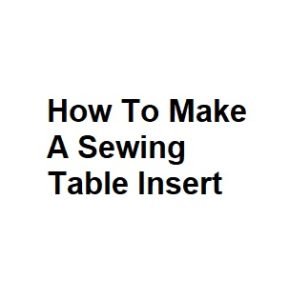A sewing table insert is a valuable accessory for any sewing enthusiast. It provides a smooth and level surface around your sewing machine, making it easier to work on large or delicate projects. Creating your own sewing table insert can be a cost-effective and customized solution. In this guide, we’ll walk you through the steps to make a sewing table insert.
Materials You’ll Need
Before you start making your sewing table insert, gather the necessary materials:
- Plywood or Acrylic Sheet: You’ll need a piece of plywood or acrylic sheet large enough to fit the opening in your sewing table.
- Measuring Tape and Pencil: For precise measurements and marking.
- Saw: To cut the plywood or acrylic sheet to the required size.
- Router: For creating the opening in the insert.
- Sanding Block or Sandpaper: To smooth the edges.
- Screwdriver and Screws: To attach the insert to your sewing table.
- Safety Equipment: Wear safety glasses and hearing protection when using power tools.
Steps to Make a Sewing Table Insert
Follow these steps to create a sewing table insert:
1. Measure the Sewing Machine Opening
Start by measuring the dimensions of the opening in your sewing table where the sewing machine sits. Measure the width, length, and the depth of the opening. Record these measurements carefully, as they will determine the size of your insert.
2. Cut the Plywood or Acrylic Sheet
Using your saw, carefully cut the plywood or acrylic sheet to match the measurements you recorded in the previous step. Ensure that the edges are straight and clean.
3. Create the Opening for the Sewing Machine
To accommodate your sewing machine, you’ll need to create an opening in the insert. Mark the dimensions of the sewing machine’s base on the plywood or acrylic sheet. Then, use a router to carefully cut out the opening. Take your time to ensure a precise fit for your sewing machine.
4. Sand the Edges
After cutting the opening, use a sanding block or sandpaper to smooth the edges of the insert. This will prevent any rough or sharp edges that could potentially snag fabric.
5. Test the Fit
Place the insert into the sewing table’s opening and test the fit. Ensure that it sits flush and level with the table surface and that the sewing machine fits snugly into the opening.
6. Attach the Insert
Secure the insert to the sewing table using screws. Depending on your table’s design, you may need to attach small wooden cleats to the underside of the insert to provide support and stability. Make sure the insert is firmly in place but can be easily removed if needed.
7. Finish the Insert (Optional)
If desired, you can finish the surface of the insert with a coat of paint or varnish to match your sewing table’s aesthetic.
8. Customization Options
While the basic sewing table insert serves to create a level surface around your sewing machine, you can customize it further to suit your needs:
- Accessory Trays: Add small compartments or trays to hold sewing tools, pins, or even a small pincushion. These can be attached to the sides of the insert or incorporated into the design.
- Thread Spool Holders: Install holders for your thread spools on the sides or back of the insert. This keeps your threads organized and easily accessible while you work.
- Adjustable Inserts: If you have multiple sewing machines with different base sizes, consider making multiple inserts, each tailored to a specific machine. This allows you to switch inserts depending on your sewing project.
- LED Lighting: Incorporate LED lights into the insert to provide well-lit workspaces for intricate sewing tasks. This can reduce eye strain and improve visibility.
- Raised Edge: Adding a raised edge or lip around the insert can help prevent small items from rolling off the table while you work.
9. Maintain and Upgrade
Over time, your sewing table insert may experience wear and tear. Keep an eye on the condition of the insert, and if you notice any warping or damage, it’s relatively simple to create a new one using the same process outlined here.
If you find that your sewing machine’s model or needs change, you can easily modify or replace the insert to accommodate your new requirements.
10. Storage and Portability
If you have limited space in your sewing area, consider making the insert easily removable. You can store it under the table or in a designated space when not in use. Additionally, if you attend sewing classes or workshops, having a portable insert can be a convenient way to bring your customized sewing surface with you.
Tips and Considerations
- If you’re using acrylic sheet, be extra cautious when cutting and routing to prevent cracking. Acrylic can be brittle, so take your time and use the appropriate tools.
- Measure twice and cut once. Precise measurements are crucial to ensure a snug fit for your sewing machine.
- Some sewing enthusiasts add a layer of quilt batting or felt to the insert’s top surface to create a soft and padded work area for quilting and delicate fabrics.
- Keep safety in mind while working with power tools. Always follow safety guidelines and wear appropriate protective gear.
Creating a sewing table insert can enhance your sewing experience by providing a stable and smooth surface for your projects. With careful measurements and the right tools, you can customize an insert that perfectly fits your sewing machine and table, making your sewing tasks more efficient and enjoyable.
